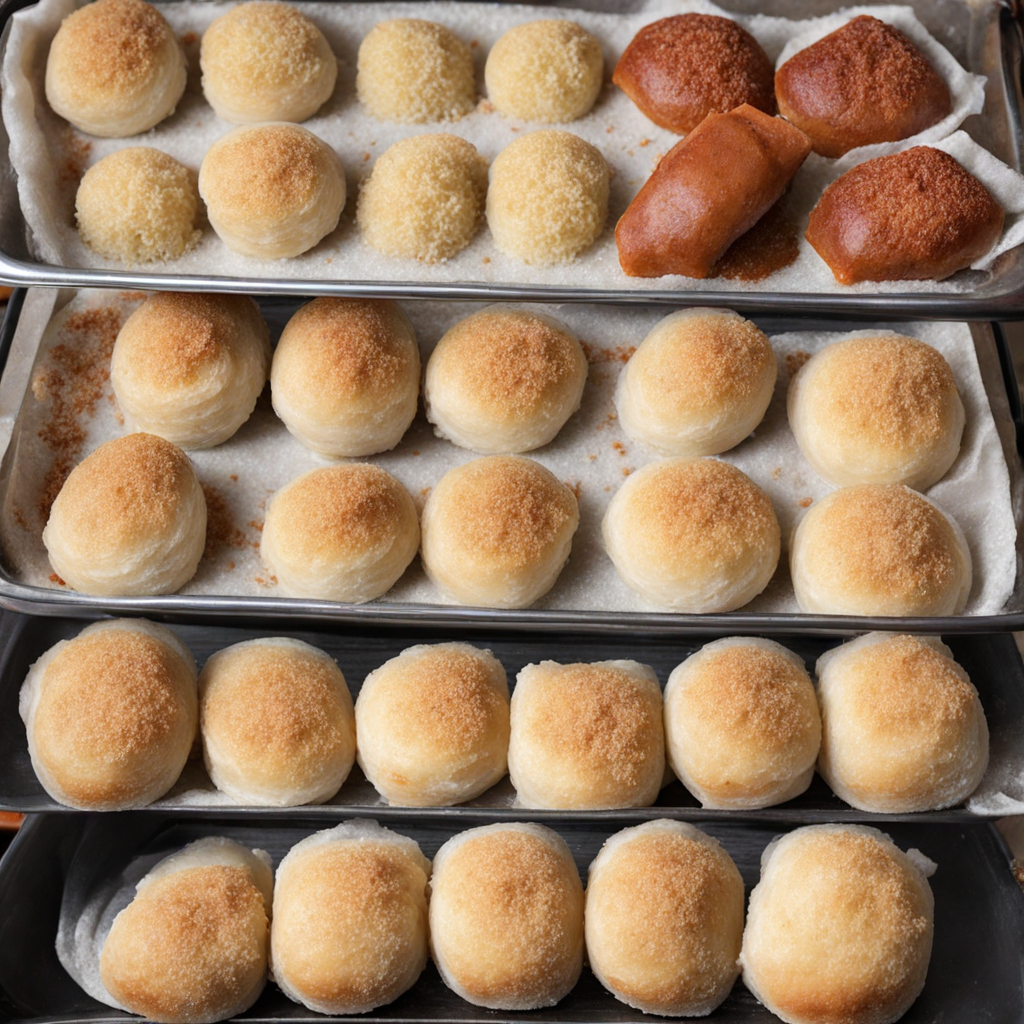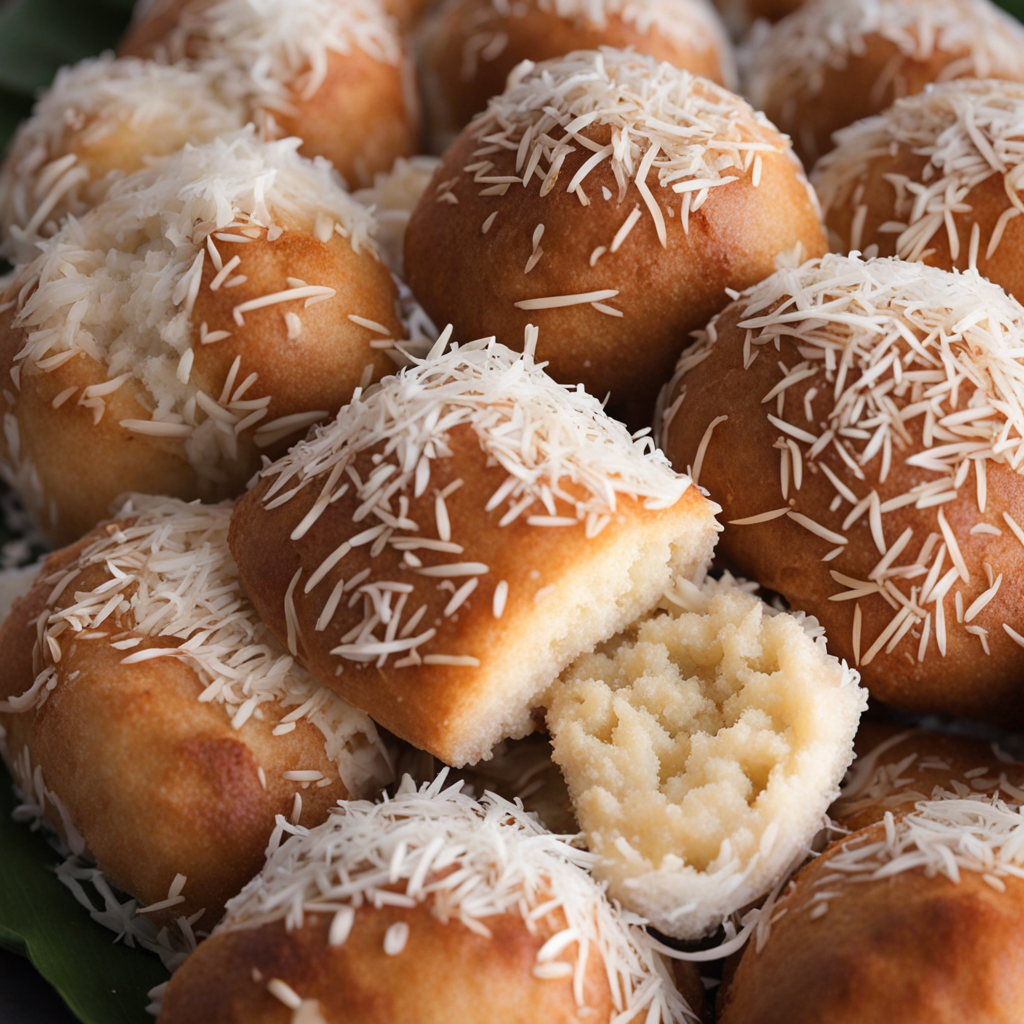Salara
Salara is a delightful and fragrant sweet bread that hails from the rich culinary traditions of Guyana. This unique treat is characterized by its vibrant orange color, which comes from the generous addition of freshly grated coconut and turmeric. The bread is typically made with a soft, pillowy dough that is enriched with coconut milk, giving it a rich and moist texture. The aroma of freshly baked Salara wafts through the air, beckoning food lovers to indulge in its warmth and sweetness. The filling of Salara is what truly sets it apart, offering a burst of flavor with every bite. A mixture of sugar, spices, and grated coconut is rolled into the dough, creating a delightful contrast of sweet and savory. The spices often include cinnamon and nutmeg, which infuse the bread with a warm, comforting taste. As you slice into it, you’ll find the filling beautifully swirled, inviting you to experience a taste of the tropics, reminiscent of the lush landscapes of Guyana. Salara is not just a treat for special occasions; it is often enjoyed as a breakfast item or an afternoon snack, paired perfectly with a cup of tea or coffee. Its versatility makes it a beloved staple in many households, where it brings people together over shared moments and stories. Whether you are savoring it fresh out of the oven or toasted with a bit of butter, each bite of Salara offers a delightful journey into the heart of Guyanese culture, making it a must-try for anyone eager to explore new flavors.
How It Became This Dish
The History and Cultural Significance of Salara in Guyana Salara, a vibrant and sweet bread, holds a cherished place in the culinary heritage of Guyana. Its striking orange hue, derived from the use of turmeric and the rich, sweet filling of grated coconut, sugar, and spices, makes it a beloved treat that is both visually appealing and delicious. To understand the significance of Salara within Guyanese culture, one must explore its origins, the evolution of its recipe, and its role in various social contexts. #### Origins The origins of Salara can be traced back to the diverse tapestry of cultures that have shaped Guyana over centuries. The country, located on the northeastern coast of South America, is a melting pot of Indigenous peoples, African slaves, Indian indentured laborers, Chinese immigrants, Portuguese settlers, and European colonizers. Each of these groups contributed to the culinary landscape of Guyana, and Salara is a prime example of this fusion. The bread itself is believed to have roots in East Indian culinary traditions, brought to Guyana by indentured laborers who arrived in the late 19th and early 20th centuries following the abolition of slavery. These laborers brought with them an array of spices, cooking techniques, and ingredients that became integral to Guyanese cuisine. The use of coconut, a common ingredient in Indian sweets, is a notable example. The vibrant color of Salara is often attributed to the use of turmeric, a spice widely used in Indian cooking, which adds both flavor and visual appeal. #### Cultural Significance Salara is more than just a food item; it is a symbol of community and cultural identity in Guyana. Traditionally, it is prepared during festive occasions, family gatherings, and religious celebrations, particularly in the context of Hindu festivals such as Diwali. The act of making Salara often brings families and communities together, fostering a sense of unity and shared heritage. In addition to its role in festivities, Salara also serves as a nostalgic reminder of home for many Guyanese, particularly those in the diaspora. For expatriates living abroad, the taste of Salara evokes memories of childhood, family gatherings, and the rich cultural fabric of their homeland. Sharing a slice of Salara with friends and family becomes a way to bridge the gap between cultures and generations, preserving the culinary traditions of Guyana even in foreign lands. #### Development Over Time As with many traditional foods, the recipe for Salara has evolved over time, influenced by changes in availability of ingredients and culinary trends. While the core elements of the bread remain consistent—flour, sugar, coconut, and spices—the methods of preparation and presentation have adapted to suit modern tastes. In earlier times, Salara would have been made using hand-grated coconut, a labor-intensive process that required significant skill and effort. Today, many cooks opt for pre-packaged grated coconut, which simplifies preparation and allows for quicker assembly. Additionally, variations of the filling have emerged, with some incorporating fruits, nuts, or even chocolate, appealing to a broader range of palates. Despite these adaptations, the essence of Salara remains unchanged. It continues to be celebrated for its balance of sweetness and spice, texture and aroma, making it a favorite among both young and old. The bread's unique flavor profile, often described as a fusion of sweet and savory, reflects the multicultural influences that define Guyanese cuisine. #### Salara in Contemporary Guyana In contemporary Guyana, Salara is not only a cherished homemade treat but also a commercial product found in bakeries and markets across the country. Its popularity has led to the establishment of various artisanal bakeries that specialize in traditional Guyanese foods, where Salara is often featured prominently. These establishments not only cater to local demand but also attract tourists seeking to experience the authentic flavors of Guyana. Moreover, social media has played a pivotal role in popularizing Salara beyond its traditional boundaries. Food bloggers and influencers share recipes, photos, and stories about this delightful bread, helping to elevate its profile and connect with a global audience. Virtual cooking classes and cultural exchanges have also emerged, allowing people from different backgrounds to learn about and appreciate Guyanese culinary traditions, including the making of Salara. #### The Future of Salara As Guyana continues to evolve, so too does the significance of Salara within its cultural framework. The bread stands as a testament to the resilience of culinary traditions amid changing times. The preservation of recipes and techniques, along with the incorporation of modern elements, illustrates how traditional foods can adapt and thrive in contemporary society. Efforts to promote Guyanese cuisine on the international stage have also gained momentum, with Salara often highlighted as a quintessential dish. Culinary festivals, food fairs, and cultural events showcase the richness of Guyanese food, helping to foster a greater appreciation for its unique flavors and historical significance. In conclusion, Salara represents more than just a delicious treat; it embodies the rich cultural heritage of Guyana and the stories of its people. From its origins rooted in the diverse influences of various immigrant groups to its modern-day role as a symbol of community and identity, Salara reflects the resilience and adaptability of Guyanese culinary traditions. As it continues to be embraced by new generations and shared across borders, the legacy of Salara is sure to endure, connecting the past with the present and future.
You may like
Discover local flavors from Guyana







